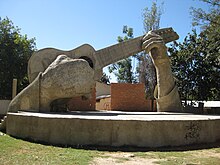Aiquile
| Aiquile | ||
|---|---|---|
 Aiquile train station |
||
| Basic data | ||
| Residents (state) | 7863 pop. (2012 census) | |
| rank | Rank 63 | |
| height | 2260 m | |
| Post Code | 03-0201-0105-6001 | |
| Telephone code | (+591) | |
| Coordinates | 18 ° 12 ′ S , 65 ° 11 ′ W | |
|
|
||
| politics | ||
| Department | Cochabamba | |
| province | Narciso Campero Province | |
| climate | ||
 Climate diagram Mizque |
||
Aiquile is a small town in the department of Cochabamba in the South American Andean state of Bolivia . It was hit by a strong earthquake in May 1998. After that, an almost complete reconstruction of the village was necessary.
Location in the vicinity

Aiquile is the central place of the district ( Bolivian : Municipio ) Aiquile and seat of the administration of the province Narciso Campero . The place lies at an altitude of 2260 m in a valley of the Sierra de Catatiri , which extends between Cordillera Oriental and Cordillera Central in north-south direction.
geography
Aiquile lies between the mountain ranges of the Bolivian Cordillera Oriental and the Cordillera Central. The climate is characterized by year-round spring-like temperatures and low rainfall.
The average annual temperature of the region is around 20 ° C (see Mizque climate diagram) and an annual rainfall of 550 mm. The summer from October to March has monthly average temperatures of 22 ° C, the coldest months are June and July with a good 17 ° C. From April to October there is a dry season with precipitation below 20 mm, the summer from December to February has rainfall of 110 to 135 mm.
Transport network
Aiquile is 218 kilometers by road from Cochabamba , the capital of the department.
The city is located on the 898-kilometer Ruta 5 highway , which crosses the Bolivian Altiplano from northeast to southwest. To the north, a dirt road leads 89 kilometers to Epizana and meets the Ruta 7 , which leads from Cochabamba into the lowlands to Santa Cruz . To the south, Ruta 5 leads to Sucre, 136 kilometers away, and from there further west to the Chilean border.
Aiquile has direct bus links to Cochabamba and Sucre. Furthermore, Aiquile was the terminus of the railway line from Cochabamba via Mizque . This railway line was served three times a week by a Ferrobus . However, the journey to Cochabamba only took about half as long by bus as with the Ferrobus.
population
The population of the village has increased by more than a third in the past two decades:
| year | Residents | source |
|---|---|---|
| 1992 | 5 525 | census |
| 2001 | 7 381 | census |
| 2012 | 7 863 | census |
Individual evidence
- ↑ Aiquile and Totora: When the Earth Shakes
- ^ INE - Instituto Nacional de Estadística Bolivia: Censo 2012. Retrieved October 18, 2019 (Spanish).
Web links
- Relief map of the Aiquile region 1: 250,000 (PDF; 9.35 MB)
- Municipio Aiquile - General Maps No. 30201
- Municipio Aiquile - detailed map and population data (PDF; 801 kB) ( Spanish )
- Departamento Cochabamba - social data of the municipalities (PDF; 7.58 MB) ( Spanish )
